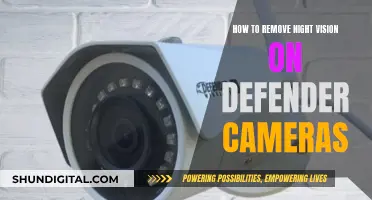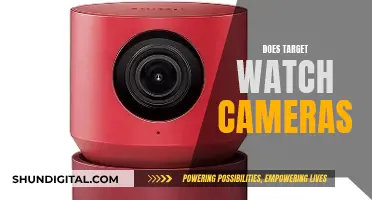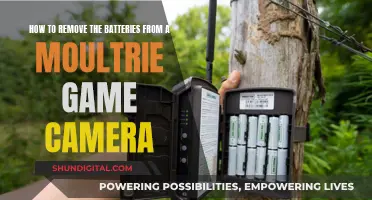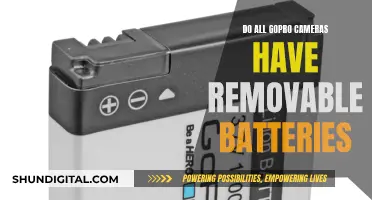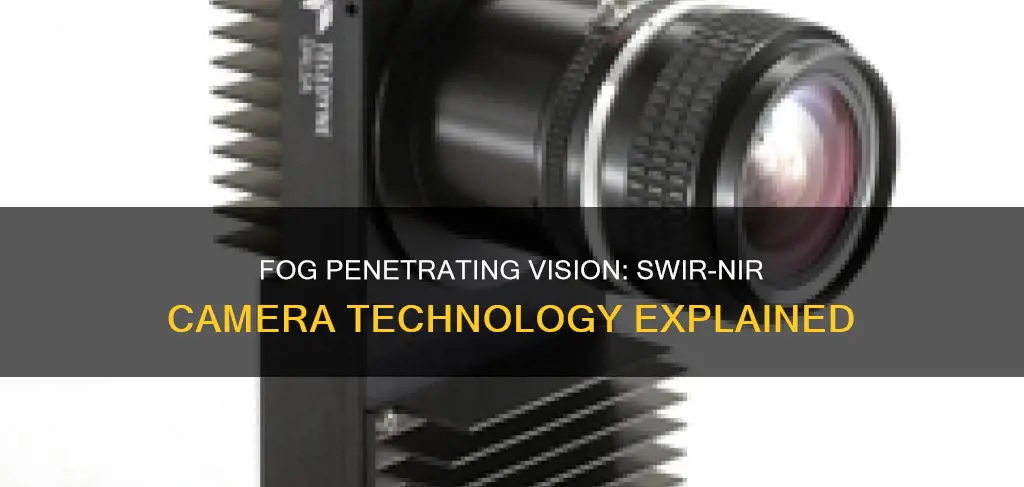
Short-wave infrared (SWIR) cameras can see through fog, haze, and other atmospheric conditions to spot unwanted activities and identify objects. SWIR cameras capture light reflected or absorbed by an object, whereas MWIR and LWIR cameras detect heat emitted by an object. SWIR cameras are used in military and emergency services for surveillance and reconnaissance, as well as in agriculture, electronics manufacturing, counterfeit currency detection, solar cell inspection, and art authentication.
What You'll Learn
- SWIR cameras can see through fog, clouds, and hazy air pollution
- SWIR cameras can be used for surveillance and reconnaissance
- SWIR cameras can be used for quality control and to identify fraudulently printed paper money
- SWIR cameras can be used to detect gas leaks
- SWIR cameras can be used to see through haze for port and homeland security

SWIR cameras can see through fog, clouds, and hazy air pollution
SWIR cameras are a type of short-wave infrared camera that can see through fog, clouds, and hazy air pollution. They are used in military and emergency services for surveillance and reconnaissance. SWIR cameras can also be used to identify defects in produce, capture images of the night sky, or create artistic nighttime cityscape images. The pictures produced by these cameras look like regular black-and-white photographs.
SWIR cameras capture light reflected or absorbed by an object, whereas MWIR and LWIR cameras detect heat emitted by an object. This is why SWIR cameras are able to see through fog and other atmospheric conditions that may obscure visibility. The impact of haze and smoke disappears in the short-wave infrared (SWIR) range of 0.9 to 1.7 μm. SWIR images are formed by light reflected by the objects observed and can be interpreted easily and directly.
In addition to seeing through fog, SWIR cameras can also see through certain materials such as silicon and water vapor. They can be used for electronic board inspection, solar cell inspection, produce inspection, surveillance, anti-counterfeiting, and process quality control. For example, they can be used to detect bruising on fruit that isn't visible to the naked eye or to identify counterfeit currency.
SWIR technology relies on Indium Gallium Arsenide (InGaAs), Germanium (Ge), or Indium Gallium Germanium Phosphide (InGaAsP) to detect light reflected in wavelengths that silicon will not absorb. InGaAs SWIR imagers are complementary to thermal imagers when it comes to vision enhancement and low visibility in poor weather conditions. While thermal imagers can detect the presence of a warm object, SWIR cameras can identify what that object is. This makes SWIR cameras particularly useful in port and harbor security, where fog and haze are common.
The Japanese Movie 'Don't Stop Camera' is a Must-Watch
You may want to see also

SWIR cameras can be used for surveillance and reconnaissance
SWIR cameras capture images in the short-wave infrared range, typically from 0.9 to 1.7 μm, although some cameras have an extended range down to 0.4 μm or up to 2.5 μm. They work by sensing light reflected by objects, similar to visible light cameras, which makes image interpretation easier compared to thermal imaging cameras. SWIR cameras can also identify objects that thermal cameras cannot, such as ships, vehicles, and personnel. This makes them valuable for port and harbour security, where fog and haze are common.
SWIR cameras have high sensitivity and a wide dynamic range, allowing them to capture clear images even in challenging lighting conditions. They can also see through water vapour and certain materials like silicon, making them useful for a range of applications beyond surveillance and reconnaissance. For example, in agriculture, SWIR cameras can inspect produce for defects and in electronics manufacturing, they can be used for quality control.
SWIR cameras use Indium Gallium Arsenide (InGaAs) sensors, which are capable of performing in the specific SWIR range. These sensors are typically ITAR-restricted, meaning their import and export are strictly regulated by the US government. However, SWIR lenses can be used for commercial applications with proper licenses.
Troubleshooting Nightowl Cameras Not Showing on TV
You may want to see also

SWIR cameras can be used for quality control and to identify fraudulently printed paper money
SWIR cameras are an effective tool for quality control and fraud detection in printed paper money. They can capture information that is not visible to the human eye, enhancing precision and accuracy in various applications. Here are some ways in which SWIR cameras can be utilised for these purposes:
Quality Control
SWIR cameras are highly effective in quality control processes as they can differentiate between materials based on their composition. This capability is especially useful when distinguishing between similar materials. For instance, in a pile of black beans, a SWIR camera can identify plastic and metal pieces. This makes it ideal for quality control in industries such as agriculture, where it can be used to monitor crop health, assess soil composition, and detect moisture content. In the food industry, SWIR cameras can identify defects in fruits and vegetables and detect moisture content, ensuring the quality of the final product.
Fraudulent Money Detection
Counterfeit currency detection is another important application of SWIR cameras. They can be used to identify fraudulently printed paper money by seeing through the ink to the paper's surface. This capability allows for the detection of hidden information or alterations that may indicate counterfeit bills. The ability to capture images in the short-wave infrared range, which is not visible to the human eye, makes SWIR cameras valuable tools for fraud detection.
Enhanced Visibility
SWIR cameras offer enhanced visibility in challenging environments. They are less affected by fog, smoke, haze, and other atmospheric conditions, making them reliable for both outdoor and indoor inspections. This feature ensures that the cameras can capture clear images even in less-than-ideal conditions, providing consistent performance in diverse applications.
Material Analysis
The ability of SWIR cameras to analyse different types of materials is advantageous for quality control and fraud detection. By utilising wavelengths that silicon will not absorb, these cameras can differentiate between materials based on their composition. This capability is crucial in identifying counterfeit bills, as it allows for the detection of variations in the paper or ink used.
Cost-Effectiveness
Visible-SWIR cameras offer a cost-effective solution by eliminating the need for multiple cameras operating in different spectrums. They can capture both visible and short-wave infrared images, reducing the number of cameras required for inspections. This unification results in cost savings and simplified maintenance, making them a financially viable option for quality control and fraud detection.
The Reflection Conundrum: Mirror vs. Camera Perspectives
You may want to see also

SWIR cameras can be used to detect gas leaks
SWIR cameras are also useful in this context because they are not sensitive to thermal radiation, unlike LWIR and MWIR cameras. This means they can detect gas leaks without being affected by ambient heat. SWIR cameras can also be combined with LWIR cameras to create a spectral composite that further enhances their effectiveness in all weather and light conditions.
In addition to detecting gas leaks, SWIR cameras have a variety of other applications. They can be used for surveillance, as they can see through haze, fog, and smoke. They can also be used in agriculture, electronics manufacturing, counterfeit currency detection, solar cell inspection, and art curation.
The use of SWIR cameras for gas leak detection offers a number of benefits, including rapid and accurate detection, the ability to maintain a safe distance from hazardous leaks, and high-resolution imagery that enables the identification of small leaks.
Is Your Camera Being Watched? Here's How to Know
You may want to see also

SWIR cameras can be used to see through haze for port and homeland security
SWIR cameras are an effective tool for port and homeland security, especially in low-visibility conditions such as haze and fog. SWIR stands for short-wave infrared, and these cameras can capture images in this specific range of the infrared spectrum. The short-wave infrared range, typically from 0.9 to 1.7 μm, is known as an "atmospheric window" due to its ability to penetrate through certain atmospheric obscurants, including haze, fog, and smog. This makes SWIR cameras valuable for surveillance and security applications where visibility is often impaired.
In the context of port and homeland security, SWIR cameras offer several advantages. Firstly, they can penetrate through haze and fog, providing clear imagery that enhances situational awareness for security personnel. This capability is particularly useful in maritime environments, where haze and fog are common occurrences. SWIR cameras can help identify ships, vehicles, and personnel that may be obscured by these atmospheric conditions.
Another benefit of SWIR cameras is their ability to detect reflected light, similar to visible cameras. This is in contrast to thermal imagers, which detect the presence of warm objects against a cool background. While thermal imaging has its advantages, SWIR cameras provide more detailed information about the objects in the scene. For example, in a maritime setting, a thermal camera may detect the presence of a swimmer in the water, but a SWIR camera can provide a clearer image by detecting the reflected light, making it easier to identify the swimmer and any potential hazards they may be facing.
SWIR cameras are also useful for detecting disguises and camouflage. Natural materials, such as human hair and cotton fabric, are highly reflective in the SWIR spectrum, while artificial materials like synthetic hair used in disguises are much less so. This makes it easier to identify individuals who may be attempting to conceal their identity, adding an extra layer of security at border crossings and checkpoints.
Furthermore, SWIR cameras have excellent low-light performance and can operate both day and night without the need for additional illumination, which could alert intruders. This makes them ideal for covert surveillance operations and perimeter security, providing high-quality images even in challenging lighting conditions such as dusk, dawn, and overcast skies.
In addition, SWIR cameras have a wide dynamic range, making them suitable for various applications. They can capture images of the night sky, create artistic cityscape images, and assist in industrial inspections, such as detecting defects in glass manufacturing or analysing artwork for authenticity.
Overall, SWIR cameras are a valuable tool for port and homeland security, especially in haze and fog conditions. They provide clear imagery, aid in object identification, work well in low-light environments, and offer enhanced detection capabilities for improved security and surveillance.
The Art of Cinematography: Masterful Camera Control
You may want to see also
Frequently asked questions
SWIR stands for short-wave infrared. SWIR cameras capture light reflected or absorbed by an object, whereas MWIR and LWIR cameras detect heat emitted by an object or animal.
SWIR cameras can see through fog, clouds, haze and light pollution to create clear images. They can also be used to identify friendly personnel and avoid "friendly fire".
SWIR cameras miss the colour content of the visible realm. They also require a lens that is designed, optimised and coated for the SWIR wavelength range.


